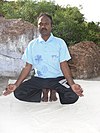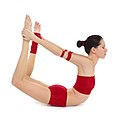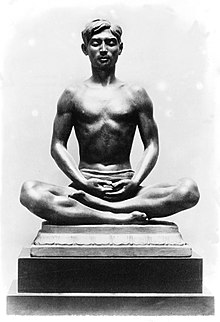Gheranda Samhita
| Part of a series on |
| Hindu scriptures and texts |
|---|
 |
|
Rig vedic
Sama vedic Yajur vedic Atharva vedic |
|
Other scriptures |
| Related Hindu texts |
|
|
Timeline |
There are no fetters like those of illusion (maya),
no strength like that which comes from discipline (yoga),
there is no friend higher than knowledge (jnana),
and no greater enemy than egoism (ahankara).
—Gheranda Samhita, 1.4
Translator: Srisa Chandra Vasu[2]
Gheranda Samhita (IAST: gheraṇḍasaṁhitā, घेरंडसंहिता, meaning “Gheranda's collection”) is a Sanskrit text of Yoga in Hinduism. It is one of the three classic texts of hatha yoga (the other two being the Hatha Yoga Pradipika and the Shiva Samhita), and one of the most encyclopedic treatise in yoga.[3][4][5] Fourteen manuscripts of the text are known, which were discovered in a region stretching from Bengal to Rajasthan. The first critical edition was published in 1933 by Adyar Library, and the second critical edition was published in 1978 by Digambarji and Ghote.[6] Some of the Sanskrit manuscripts contain ungrammatical and incoherent verses, and some cite older Sanskrit texts.[6]
It is likely a late 17th-century text, probably from northeast India, structured as a teaching manual based on a dialogue between Gheranda and Chanda.[7][8][9] The text is organized into seven chapters and contains 351 shlokas (verses).[8]
Book[edit]
The Gheranda Samhita calls itself a book on ghatastha yoga, which literally means "vessel yoga", wherein the body and mind are depicted as vessels that carry and serve the soul (atman, purusha).[8][3] It is generally considered a Hatha yoga text.[3][10][11] The text teaches a seven limbed yoga, in contrast to eight limbed yoga in Patanjali's Yogasutras, six limbed yoga taught in Goraksha Samhita, and four limbed yoga discussed in Hatha Yoga Pradipika.[3] It declares its goal to be the perfection of an individual's body, mind and soul through a seven step lifelong continuous self-development. The means of this goal include self purification, thirty two asanas it details for building body strength, twenty five mudras to perfect body steadiness, five means to pratyahara, lessons on proper nutrition and lifestyle, ten types of breathing exercises, three stages of meditation and six types of samadhi.[12]
The text reverentially invokes Hindu god Shiva as well as Vishnu, with verses such as 5.77 and 7.4 suggesting that the writer was also inspired by Advaita Vedanta ideas such as "I am Brahman [Supreme Soul] alone, and nothing else; my form is truth, consciousness and bliss (satcitananda); I am eternally free".[13]
Structure[edit]
Gheranda Samhita is a step by step detailed manual of yoga taught by sage Gheranda to student Chanda.[14] Unlike other hatha yoga texts, the Gheranda Samhita speaks of a sevenfold yoga:[15][16]
- Shatkarma for body cleansing
- Asana for body strengthening
- Mudra for body steadying
- Pratyahara for mind calming
- Pranayama for inner lightness
- Dhyana for inner perception
- Samādhi for self liberation and bliss
The text itself follows this division in seven chapters, and has a focus upon the ṣaṭkarmas (shatkarma), thus this text is sometimes said to describe ghatastha yoga. For instance, the Yoga Sūtras of Patañjali describes an eightfold path (yama and niyama instead of shatkarma and mudra, and addition of dharana). The closing stanzas on samadhi teach different methods than those described by Patanjali.
The earliest translation of the text into English was by Srisa Chandra Vasu.[4][17]
Asanas[edit]
The Gheranda Samhita describes the following āsanas.
| Asanas (postures) described in Gheranda Samhita | |||||
|---|---|---|---|---|---|
| Sanskrit name | English | Image | Gheranda Samhita verse #[18] |
Hatha Yoga Pradipika verse #[18][19] |
Shiva Samhita verse #[18] |
| Siddhāsana | Perfected | 
|
2.7 | 1.35-43 | 3.97-101 |
| Padmāsana | Lotus | 
|
2.8 | 1.44-49 | 3.102-107 |
| Bhadrasana | Fortunate | 
|
2.9-10 | 1.53-54 | Absent |
| Muktāsana | Freedom | 
|
2.11 | Absent | Absent |
| Vajrāsana | Thunderbolt | 
|
2.12 | Absent | Absent |
| Svastikāsana | Auspicious | 2.13 | 1.19 | 3.113-115 | |
| Siṁhāsana | Lion | 
|
2.14-15 | 1.50-52 | Absent |
| Gomukhāsana | Cow face | 
|
2.16 | 1.20 | Absent |
| Virasana | Hero | 
|
2.17 | Absent | 3.21 |
| Dhanurāsana | Bow | 
|
2.18 | 1.25 (variance) |
Absent |
| Śavāsana | Death | 
|
2.19 | 1.32 | Absent |
| Guptāsana | Secret | 
|
2.20 | Absent | Absent |
| Matsyāsana | Fish |  |
2.21 | Absent | Absent |
| Matsyendrāsana | Lord of the fishes | 
|
2.22-23 | 1.26-27 | Absent |
| Gorakshasana | Cowherd | 2.24-25 | 1.28-29 | 3.108-112 | |
| Paschimottanasana | Seated Forward Bend | 
|
2.26 | Absent | Absent |
| Utkaṭāsana | Superior | 2.27 | Absent | Absent | |
| Sankatasana | Contracted | 2.28 | Absent | Absent | |
| Mayūrāsana | Peacock | 2.29-30 | 1.30-31 | Absent | |
| Kukkutasana | Rooster | 
|
2.31 | 1.23 | Absent |
| Kūrmāsana | Tortoise | 
|
2.32 | 1.22 | Absent |
| Uttana Kurmasana | Raised Tortoise | 
|
2.33 | 1.24 | Absent |
| Mandukasana | Frog | 2.34 | Absent | Absent | |
| Uttana Mandukasana | Raised Frog | 2.35 | Absent | Absent | |
| Vrikshasana | Tree | 
|
2.36 | Absent | Absent |
| Garuḍāsana | Eagle | 
|
2.37 | Absent | Absent |
| Trishasana | Bull | 2.38 | Absent | Absent | |
| Shalabhasana | Locust (Grasshopper) |

|
2.39 | Absent | Absent |
| Makarāsana | Crocodile | .jpg/120px-Makarasana_Asana_(Crocodile_Posture).jpg)
|
2.40 | Absent | Absent |
| Ushtrasana | Camel | 
|
2.41 | Absent | Absent |
| Bhujaṅgāsana | Serpent | 
|
2.42-43 | Absent | Absent |
| Yogasana | Union | 
|
2.44-45 | Absent | Absent |
References[edit]
- ^ James Mallinson (2004). The Gheranda Samhita: The Original Sanskrit and an English Translation. Yoga Vidya. pp. 70–72. ISBN 978-0-9716466-3-6.
- ^ Rai Bahadur Srisa Chandra Vasu (1996). The Gheranda Samhita. Munshiram Manoharlal. pp. 2–3. ISBN 978-8121507349.
- ^ a b c d James Mallinson (2004). The Gheranda Samhita: The Original Sanskrit and an English Translation. Yoga Vidya. pp. ix–x. ISBN 978-0-9716466-3-6.
- ^ a b B. Heimann (1937), Review: The Ǧheraṇda Saṁhitā. A Treatise on Haṭha Yoga by Śrīś Chandra Vasu, The Journal of the Royal Asiatic Society of Great Britain and Ireland, Cambridge University Press, No. 2 (Apr., 1937), pp. 355-357
- ^ Georg Feuerstein (2011). The Path of Yoga: An Essential Guide to Its Principles and Practices. Shambhala Publications. pp. 13–14. ISBN 978-0-8348-2292-4.
- ^ a b James Mallinson (2004). The Gheranda Samhita: The Original Sanskrit and an English Translation. Yoga Vidya. pp. xiv–xvi. ISBN 978-0-9716466-3-6.
- ^ James Mallinson (2004). The Gheranda Samhita: The Original Sanskrit and an English Translation. Yoga Vidya. pp. x–xiii. ISBN 978-0-9716466-3-6.
- ^ a b c Mikel Burley (2000). Haṭha-Yoga: Its Context, Theory, and Practice. Motilal Banarsidass. pp. 8–9. ISBN 978-81-208-1706-7.
- ^ Georg Feuerstein (2011). The Path of Yoga: An Essential Guide to Its Principles and Practices. Shambhala Publications. pp. 55, 59–60. ISBN 978-0-8348-2292-4.
- ^ Roshen Dalal (2010). Hinduism: An Alphabetical Guide. Penguin Books. p. 157. ISBN 978-0-14-341421-6.
- ^ Guy L. Beck (1993). Sonic Theology: Hinduism and Sacred Sound. University of South Carolina Press. pp. 102–103. ISBN 978-0-87249-855-6., Quote: "The Gheranda Samhita, Siva Samhita and Hatha Yoga Pradipika are three of the most important Hatha Yoga texts and are intimately connected with the practice of Nada Yoga as propounded by Gorakhshanath and his school."
- ^ James Mallinson (2004). The Gheranda Samhita: The Original Sanskrit and an English Translation. Yoga Vidya. pp. x–xi. ISBN 978-0-9716466-3-6.
- ^ James Mallinson (2004). The Gheranda Samhita: The Original Sanskrit and an English Translation. Yoga Vidya. pp. xiii–xiv. ISBN 978-0-9716466-3-6.
- ^ Steven J. Rosen (2011). Food for the Soul: Vegetarianism and Yoga Traditions. ABC-CLIO. pp. 28–29. ISBN 978-0-313-39704-2.
- ^ James Mallinson (2004). The Gheranda Samhita: The Original Sanskrit and an English Translation. Yoga Vidya. pp. ix–xvii, 1–2, 16–18, 60–61, 86–91, 113–116, 119–123. ISBN 978-0-9716466-3-6.
- ^ Mark Stephens (2011). Teaching Yoga: Essential Foundations and Techniques. North Atlantic. pp. 17–20. ISBN 978-1-58394-472-1.
- ^ Gheraṇḍa; S.C. Vasu (Translator) (1895). The Gheranda Sanhita: A Treatise on Hatha Yoga. Bombay Theosophical.
- ^ a b c Richard Rosen 2012, pp. 80-81.
- ^ Gerald James Larson, Ram Shankar Bhattacharya & Karl H. Potter 2008, pp. 491-492.
Sources[edit]
- Bahadur, Rai and Srisa Chandra Vasu. 1914-15 The Gheranda Samhita, (source)
- Gerald James Larson; Ram Shankar Bhattacharya; Karl H. Potter (2008). Yoga: India's Philosophy of Meditation. Motilal Banarsidass. ISBN 978-81-208-3349-4.
- James Mallinson (2011). Knut A. Jacobsen; et al., eds. Haṭha Yoga in the Brill Encyclopedia of Hinduism, Vol. 3. Brill Academic. pp. 770–781. ISBN 978-90-04-27128-9.
- Richard Rosen (2012). Original Yoga: Rediscovering Traditional Practices of Hatha Yoga. Shambhala Publications. ISBN 978-0-8348-2740-0.
External links[edit]
- Version, interpretation and translation into Spanish, Dr. Fernando Estévez Griego (PDF)
- Translation and commentary by Rai Bahadur Srisa Chandra Vasu, K. Pattabhi Jois school web.archive.org (PDF) (summary)

